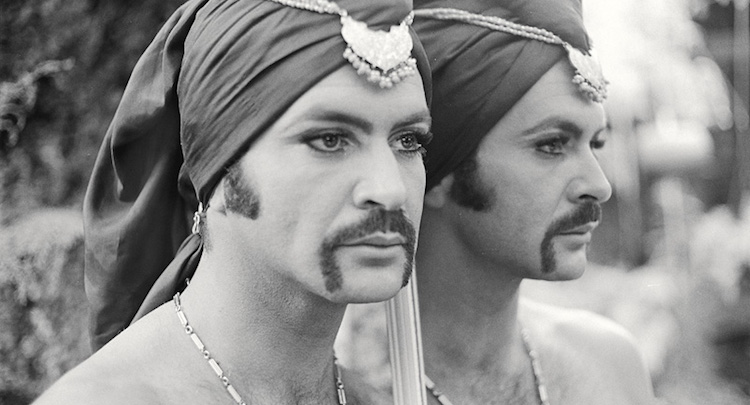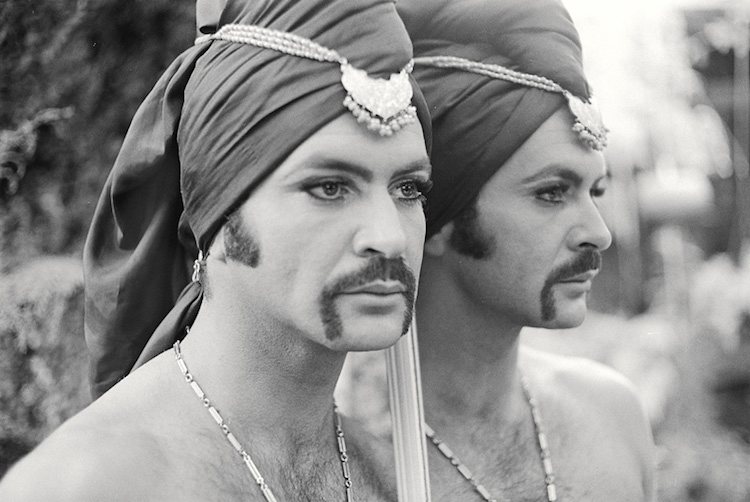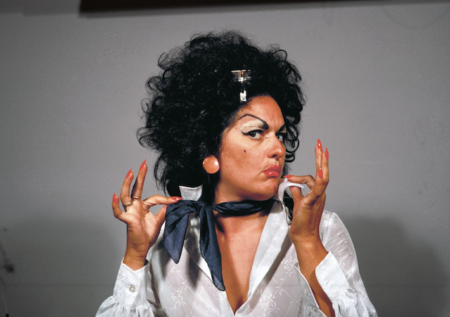
Houston’s Lawndale Art Center Showcases First-ever Archive of LGBTQ Chicanx Art
Axis Mundo: Queer Networks in Chicano L.A is on display through June 6.

Houston is celebrating Latinx art like never before, with over 80 Latin-focused events taking place in the city this spring.
While the number of Latinx creations being showcased sets a Space City record, one art exhibit in particular is also making history. Axis Mundo: Queer Networks in Chicano L.A., on display at Lawndale Art Center through June 6, is the first-ever archive of works by LGBTQ Mexican-American artists.
Axis Mundo explores the intersections among a Los Angeles network of over 50 queer Chicanx artists between the late 1960s and early 1990s. The traveling exhibition, curated by Ondine Chavoya and David Evans Frantz in collaboration with the ONE National Gay & Lesbian Archives at the USC Libraries and the Museum of Contemporary Art, Los Angeles, highlights the work of an often-overlooked community that not only contributed to the arts, but often did so through visual critiques of the violence and discrimination it endured.
“While developed from an excavation of history that is particular to Los Angeles, Axis Mundo frames the work of these artists within both national and international artistic cultural forces, writing a history of queer Chicano art that is long overdue,” says Joseph Hawkins, director of the ONE Archives. “Chavoya and Frantz should be commended for the dogged perseverance they displayed in uncovering a history that has gone largely unwritten and unexplored.”
Many of the objects featured in Axis Mundo have never been exhibited in museums, and several are on display for the first time since they were produced. Chavoya says that the lack of recognition for these artists has to do with xenophobia, institutional racism, and the exclusionary policies of some museums.
“What we see in this exhibition are artists who recognized, early on in their careers, that the museum was a closed field to them. So what they did was create their own means of access—their own alternative art institutions through which they could both exhibit, produce, and circulate their work,” Chavoya tells Las Vegas Weekly. When he and Frantz began research on the artists, they spent time in Mexico, Spain, and England, meeting with the artists’ families and friends to learn more about their histories.

“Oftentimes, when we were reaching out to artists or surviving partners and family members, they would tell us, ‘You’re the first ones to come and ask about our loved one,’” Chavoya recalls.
Had it not been for the work of Chavoya and Frantz, Edmundo “Mundo” Meza—the gay artist that Axis Mundo references—may have been forgotten. Meza, who was born in Mexico in 1955 and raised in East Los Angeles, was a central figure among the artists and activists of his generation. He was primarily a painter, but was also known for his performances, design, and installation work.
Meza collaborated with many of his peers to develop new art techniques amid emerging movements of political and social-justice activism. Like many of the artists featured in Axis Mundo, Meza was impacted by the AIDS crisis, which contributed to the erasure of his history over time. Meza’s work, which was never exhibited at museums in his lifetime, was dispersed among his family and friends after he died in 1985 of AIDS complications at age 29. The Axis Mundo exhibit marks the first time that Meza’s art has been showcased on a large scale.
While many of the artists in Axis Mundo were close collaborators, not all of them worked together or were even acquaintances. However, they each shared concerns, overlapping ideas, and social circles. In many ways, Meza’s work forms the conceptual “axis” of the exhibition, with its emphasis on many of the project’s core themes—Chicanx civil rights, gay liberation, women’s movements, and a response to the AIDS crisis.
Historic paintings, photography, performance art, mail art, ’zines, fashion, and music by Chicanx artists are on display now at Lawndale Art Center, a non-profit space that is always free to the public. Of special interest is the work of Houston’s Pauline Oliveros, a composer, performer, and writer who sought to expand the understanding of music and sound through an explicitly feminist sonic and historic landscape.

Axis Mundo’s co-curator Chavoya, a professor and leading figure in the field of Latinx art history, will visit the Center on May 11 for a public program.
Until then, our springtime of Latin art is in full swing. Houstonians can appreciate the historic creations of queer Chicanx artists at Axis Mundo, along with an abundance of works by Latinx creatives, across the city through early June.
What: Axis Mundo: Queer Networks in Chicano L.A.
When: Now through June 6(program with the curator on May 11)
Where: Lawndale Art Center, 4912 Main St.
Info: lawndaleartcenter.org










